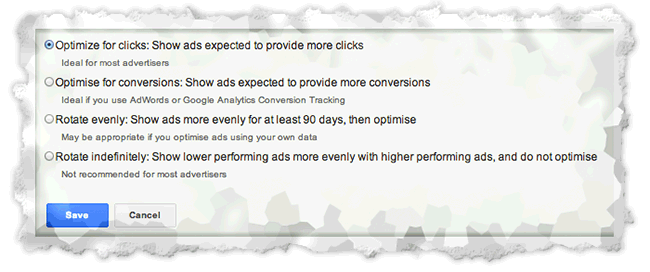Google Ad Rotation Settings: What’s best?
Loves DataThe four ad rotation options As of October 2012, there are now four ad rotations available for advertisers to set at the campaign level:

rotating-ads
While Google's advice is to stay away from rotating ads (whether for 90 days or indefinitely), we believe this represents the best optimisation opportunities for savvy advertisers who take their data seriously.
Having AdWords optimise your ads to maximise clicks or conversions sounds like a great idea. It sounds almost like a natural selection process for ads—you write a few different ads, come back later and the one with the highest fitness has been selected to take over the impressions available to your account.
The AdWords optimise options have two problems that make them sub-optimal for those who can do their own ad analysis.
Decisions made on scarce data
The first problem becomes apparent when we consider the 2 ads below:
Impressions
Clicks
CTR
Ad 1
25
5
20%
Ad 2
30
1
13.33%
Which one is the best ad?
While ad 1 seems like it's performing well, the obvious answer is that it's way too early to tell. The 2 ads do not yet have enough data to be statistically significant. (In fact, a chi squared test gives only a 24% confidence that ad 1 is the better ad.)
In our experience, the algorithm Google has been using to optimise for clicks and conversions makes decisions before there is enough data. This can create a snowball effect. In the example above, it might give ad 1 a higher impression share than ad 2. However, this can prevent the other ad from proving itself, meaning that ad 1 gets even more of the impression share. You might come back to find that ad 1 has ended up been served 95% of the time when the data doesn't strongly point to it being a better ad. If you perform your own analysis, you can make sure that any decision is made on truly significant data.
Ad optimisation is a business decision
The other problem with the AdWords options is that they optimise either based on the CTR or the conversion rate. For most websites though, the best results would have to take into account both, at least to an extent. Consider another example:
CTR
Conversion Rate
Ad 1
20%
3%
Ad 2
13.33%
6%
Which one is best ad? Ad 1 has a higher CTR but ad 2 has a higher conversion rate. You could multiply the two to get a final metric: what percentage of impressions result in conversions. However, even this method is biased to a particular situation—getting the highest total number of conversions possible. An advertiser who is more concerned with cost-effectiveness might want to apply a slightly different weighting while considering both the CTR and conversion rate.
The bottom line is that this is a strategic business decision. Leaving such a sensitive aspect of your AdWords account to a generic algorithm (eg. "optimise for clicks") may not deliver the best results for your account.
Rotate indefinitely: with great power comes great responsibility
The ad rotation setting that has the most flexibility and the biggest optimisation potential is "rotate indefinitely". This allows you to perform the optimisations at the level needed by your business and website.
As a caveat, the "rotate indefinitely" setting also has the biggest potential to go wrong—if the optimisation is done badly or not at all. It's important to be realistic and only take on this setting if you're confident that you have the time and processes to manage all your ad optimisation directly. Otherwise, one of the other ad rotation settings is the way to go.

Comments